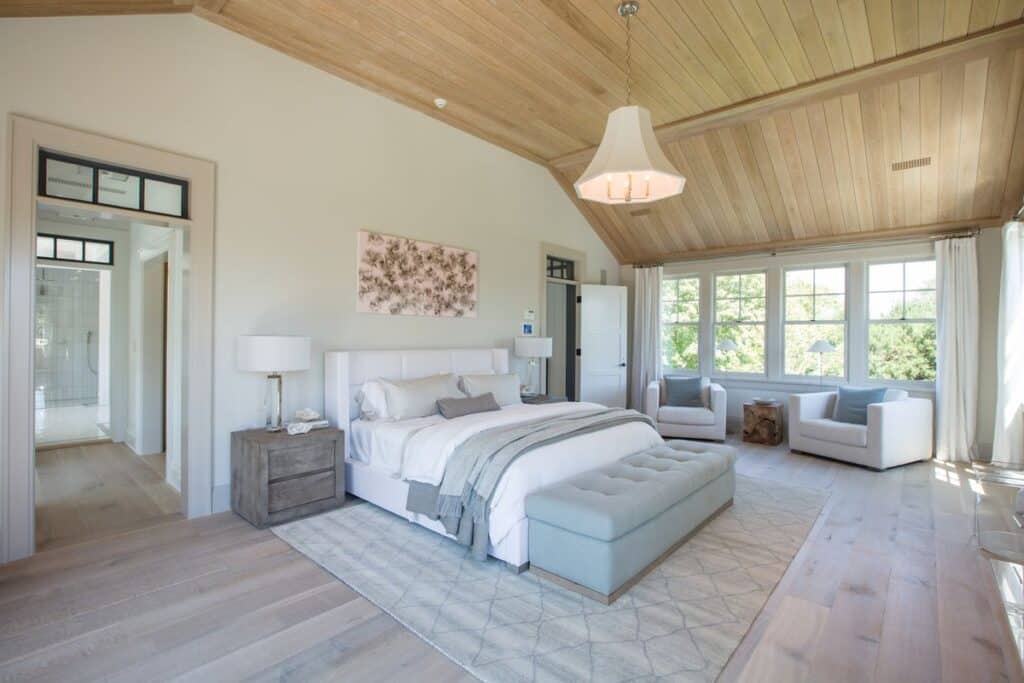Rare is the interior designer who will cheerfully decorate a spec house — and for good reason. How to furnish a home for occupants who have yet to make themselves known? Such projects oblige the designer to imagine the property’s prospective owners and act on instinct. All the minute decisions that are normally made in consultation with the homeowners — tile and floor finishes, trim details, light fixtures, wall paint, a color palette, and furniture — become wild card questions in an elaborate guessing game.
Given the stakes, most designers play it safe with innocuous interiors, clothing the house in the sartorial equivalent of plain dress. But those designers are not Alicia Murphy. For her, spec houses are a chance to take risks. She’ll try out bold color combinations and finishes that might otherwise prove a hard sell to homeowners.
The developers she works with, by contrast, grant her creative license. “I love ‘design-to-sell’ projects,” says Murphy, who is based in Amagansett, “because they allow me to respond to the space in an interesting way. Clients can have a hard time visualizing things which I know would look amazing. They’ll say, hmmm…a dark lacquered ceiling? That’s a big commitment!”

Murphy, who grew up in Huntington, Long Island, is known both for the youthful elegance of her work and her youthful clientele. In this context, one of her favorite projects in recent years was a 7,300-square-foot farmhouse-inspired home in Wainscott. Hired by a local developer to make the home move-in ready, Murphy painted the front door, the transoms over the interior doors, and the entrance hall window frames in black, “a cool design decision,” she says, “that adds dimension to hallways and rooms and served as a connecting color thread throughout.” Other touches that make a statement are the faux shagreen wallpaper on the dining room ceiling and the Murano glass chandelier — a custom piece by Venice M — over the live edge dining table.
The ‘design lab’ approach paid off in spades for Murphy. The house sold in just two weeks for $7.2 million, statement ceilings and all. “A lot of my clients live in brand new, high-end, ultra-modern buildings in the city,” she explains, “so I assumed the same would be true of most prospective buyers. I imagined a young family who liked the idea of a traditional Hamptons home, but not the lack of modern conveniences that come with it. My task was to reimagine those traditional spaces in a modern way with the level of comfort and detail my clients expect.”

For example, the main bedroom has a fireplace — just the sort of cozy touch you’d expect to find in a farmhouse. But Murphy sought to infuse the space with a slightly more modern vibe, so she installed a limestone surround and a wood mantle which she painted in Farrow & Ball’s Charleston Grey with a high gloss finish for a lacquered look. She also paneled the fourteen foot-high ceiling in oak, both in deference to the farmhouse theme and to add warmth to the space. “Rooms with double-height ceilings can look cold and cavernous if you only have white sheet rock on the walls,” Murphy explains.
Without ever losing sight of the family she imagined would one day live in the house, she furnished the rooms with pieces from Restoration Hardware and vintage items from her own collection. Her instincts, as it turned out, were right on the money. The place went to a young couple from the U.K. who wanted a Hamptons retreat, but who weren’t inclined to undertake a transatlantic design project. Fortunately, they were able to move right in, because Alicia Murphy had already made their new house a home.
















![Welcome to Le Beau Chateau, a grand French-style manor house originally built in 1937 on a 52± acre property restored and reimagined to perfection. Boasting pedigree, provenance and stunning design, 104 Dans highway has been magically transformed with a seamless infusion of bespoke finishes, quiet luxury and comfort. Represented by Rob Johnson of @brownharrisstevens. [link in bio]](https://hamptonsrealestateshowcase.com/wp-content/uploads/sb-instagram-feed-images/470917491_18481320940030135_2744230950629794022_nfull.webp)
![Located south of the highway on a quiet street, this airy and fresh, newly built 7 bedroom, 7.5 bath home exemplifies superb design with clean lines on all three levels. Bright and airy, with an open floor plan and walls of sliding glass doors overlooking the backyard and pool, this house is designed for today’s lifestyle. Represented by @sharonsternhomes of @sothebysrealty. [link in bio]](https://hamptonsrealestateshowcase.com/wp-content/uploads/sb-instagram-feed-images/470870424_18481119913030135_1232666844537840589_nfull.webp)
![This stunning waterfront home in Quogue offers direct access to Shinnecock Bay via a private boardwalk. 36 Second Neck Lane features expansive outdoor living spaces with a full kitchen, BBQ, pizza oven, and bar, plus a heated saltwater infinity pool and oversized hot tub. Represented by Nick Messina of @douglaselliman. [link in bio]](https://hamptonsrealestateshowcase.com/wp-content/uploads/sb-instagram-feed-images/470669759_18480889417030135_2117744731444738551_nfull.webp)
![Conveniently located in Water Mill, this turnkey one-level contemporary is sited at the end of a winding driveway on 1.60± private acres. The expansive, move-in ready residence has undergone a complete remodel and features 4 bedrooms and 3 bathrooms across 2,630± sq. ft. of living space. Represented by Craig Beem of @brownharrisstevens. [link in bio]](https://hamptonsrealestateshowcase.com/wp-content/uploads/sb-instagram-feed-images/470491935_18480720649030135_1941783907149758766_nfull.webp)
![Is there anything more magical than the holidays in the Hamptons? Maybe stress-free hosts who can actually enjoy them! To help you skip the last-minute scramble, we turned to expert Kathy Kuo for her top tips on getting your home holiday-ready 🎄🥂 [link in bio]](https://hamptonsrealestateshowcase.com/wp-content/uploads/sb-instagram-feed-images/470324287_553988460734287_2505109464299263530_nfull.webp)
![Cheers to holiday hosting! 🍸✨ Create the perfect at-home bar to keep the good times flowing all season long. From festive cocktails to cozy vibes, let your space shine as the ultimate gathering spot. [link in bio]](https://hamptonsrealestateshowcase.com/wp-content/uploads/sb-instagram-feed-images/470165157_1642639376465060_2596893328383899816_nfull.webp)
![A partially built 19,980± sq. ft. mansion on one of the Hamptons’ most prestigious streets, left abandoned since 2018, has finally found a buyer! The sprawling property — the largest oceanfront parcel on Meadow Lane, features arched windows and doorways, a flat roof with pyramids and conical peaks, plus a sandstone facade. Co-listed with @bespoke.realestate and @hamptonsluxurymarketleader of @thecorcorangroup. [link in bio]](https://hamptonsrealestateshowcase.com/wp-content/uploads/sb-instagram-feed-images/469724902_18479864281030135_7735465365115439625_nfull.webp)
